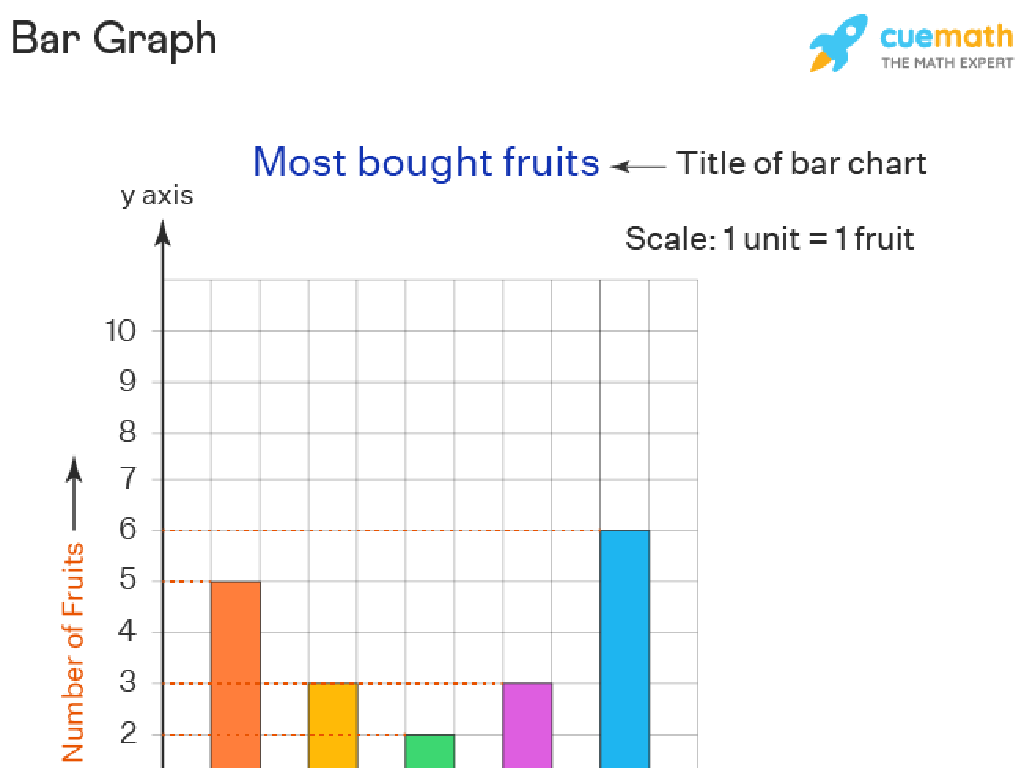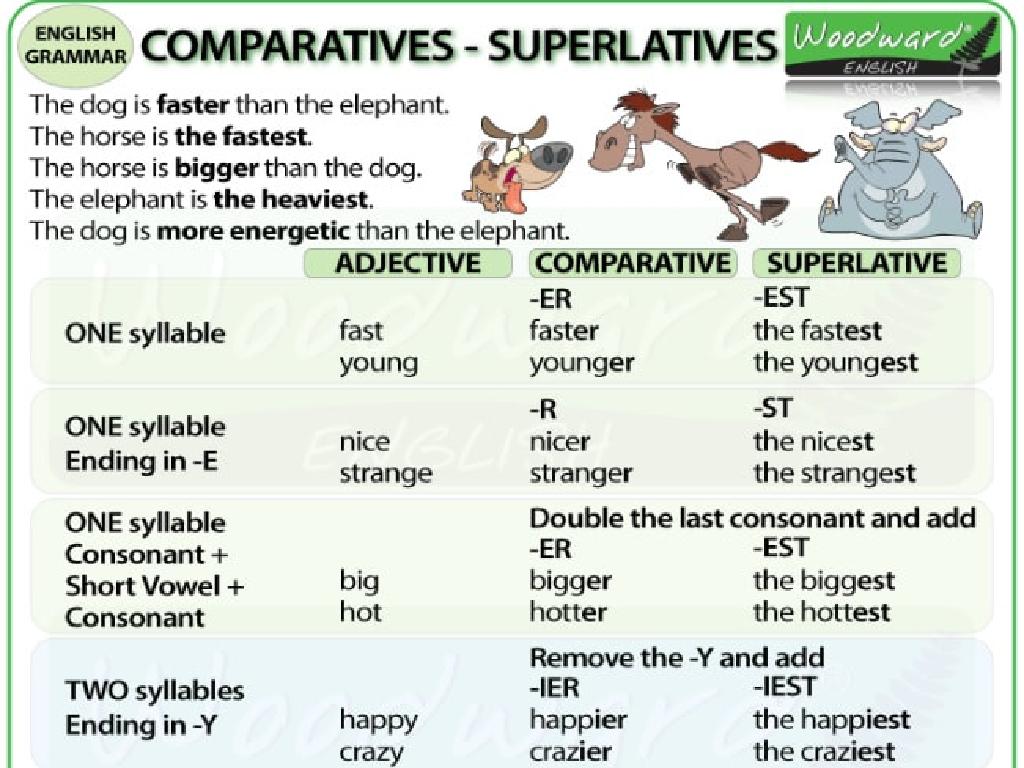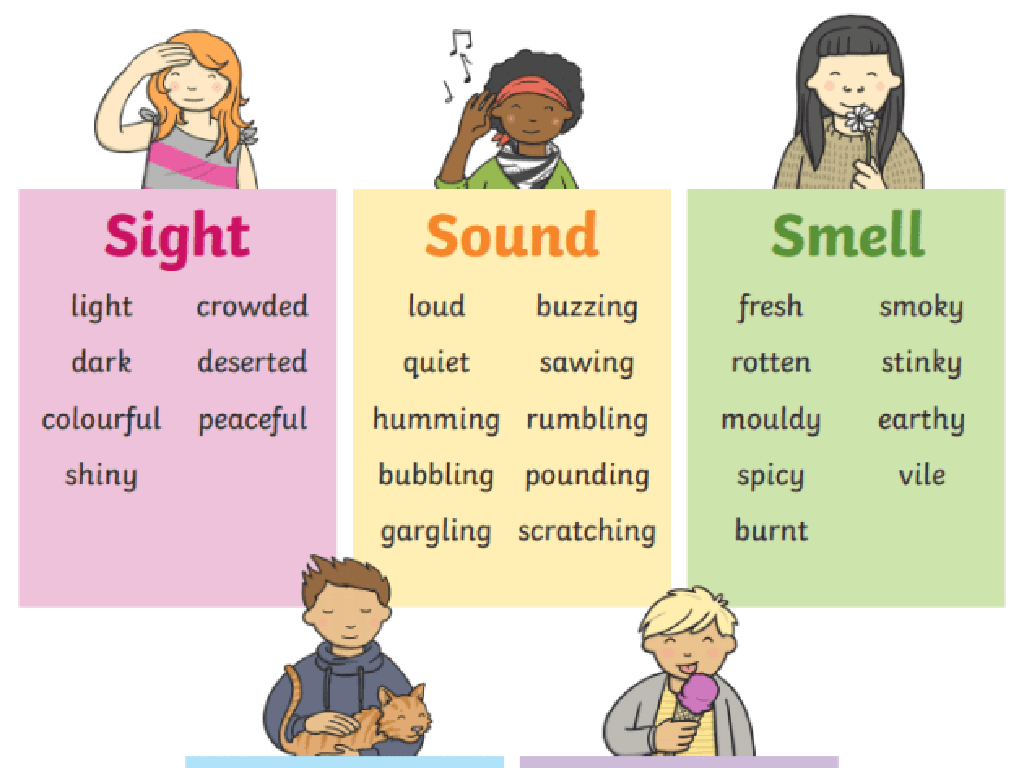Identify Adjectives
Subject: Language arts
Grade: Seventh grade
Topic: Adjectives And Adverbs
Please LOG IN to download the presentation. Access is available to registered users only.
View More Content
Welcome to Adjectives!
– Today’s Focus: Identifying Adjectives
– Role of adjectives in sentences
– Adjectives modify nouns, providing more detail.
– Significance in descriptive writing
– They add depth to writing, making it vivid and expressive.
– Practice with examples
– Let’s find adjectives in sample sentences.
|
This slide introduces the concept of adjectives to the students, emphasizing their importance in language arts. Begin by explaining that adjectives are words that describe or modify nouns, giving more information about an object’s size, shape, age, color, origin, or material. Highlight how adjectives enhance writing by allowing readers to see, hear, and feel what the writer is describing, making the text more engaging and interesting. Encourage students to think of adjectives as the coloring tools that bring a black and white sketch to life. Provide examples of sentences with and without adjectives to illustrate the difference they make. Conclude with an interactive activity where students identify adjectives in sentences from a familiar story or their favorite books.
Exploring Adjectives
– Definition of an adjective
– A word that describes a noun or pronoun
– Adjectives modify nouns
– They give more information about nouns
– Sentence examples with adjectives
– ‘The quick, brown fox jumps over the lazy dog.’ Quick and brown describe fox.
– Practice identifying adjectives
|
This slide introduces the concept of adjectives to the students. Begin with the definition, explaining that adjectives are words that describe or modify nouns and pronouns, giving more detail about them. Provide examples of adjectives in sentences to illustrate how they add color, size, shape, and other qualities to nouns, making descriptions more vivid. Encourage students to come up with their own examples and to practice identifying adjectives in various sentences. This will help them understand the role of adjectives in adding richness to language and expression.
Exploring Types of Adjectives
– Descriptive adjectives: depict qualities
– Words like ‘happy’ or ‘sad’ that describe emotions or attributes.
– Quantitative adjectives: express quantity
– Indicate amounts, like ‘many’ or ‘few’, without exact numbers.
– Demonstrative adjectives: point out nouns
– Specify particular items: ‘this’ for singular, ‘these’ for plural.
– Examples for each type of adjective
– ‘Happy dog’, ‘many stars’, ‘this book’.
|
This slide introduces students to the different types of adjectives and their roles in sentences. Descriptive adjectives are used to describe a noun’s qualities, such as color, size, or feeling. Quantitative adjectives are used when the exact number is not specified but gives an idea of quantity. Demonstrative adjectives are used to point out specific nouns and change form based on the number (singular/plural). Provide clear examples for each type to help students understand their use. Encourage students to come up with their own examples and use them in sentences to reinforce their understanding.
Adjectives in Action
– Identify adjectives in sentences
– Find and highlight the describing words
– Discuss adjective impacts
– How do these words change the sentence’s meaning?
– Interactive adjective activity
– Suggest adjectives for provided nouns
|
This slide is aimed at engaging students with the practical use of adjectives. Start by presenting sentences and asking students to identify the adjectives. Highlight how adjectives modify nouns and change the overall meaning of sentences, enhancing description and specificity. For the interactive component, provide a list of nouns and have students come up with creative adjectives to modify them. This activity will help reinforce their understanding of adjectives and encourage them to consider the effect of word choice on sentence meaning. Be prepared with examples and guide the students through the activity, ensuring that each student has the opportunity to participate.
Comparative and Superlative Adjectives
– Forming comparative adjectives
– Add ‘er’ to short adjectives, e.g., ‘tall’ becomes ‘taller’
– Forming superlative adjectives
– Add ‘est’ to short adjectives, e.g., ‘tall’ becomes ‘tallest’
– Practice adjective conversion
– Change ‘y’ to ‘i’ and add ‘er’ or ‘est’, e.g., ‘happy’ to ‘happier’ or ‘happiest’
– Rules for regular adjectives
– For long adjectives, use ‘more’ or ‘most’, e.g., ‘beautiful’ to ‘more beautiful’ or ‘most beautiful’
|
This slide introduces students to the concept of comparative and superlative adjectives. Begin by explaining that comparative adjectives are used to compare two things, while superlative adjectives are used to compare three or more things. Emphasize the spelling changes that occur when forming these adjectives, especially the change from ‘y’ to ‘i’ before adding ‘er’ or ‘est’. Provide examples for both short and long adjectives, and explain when to use ‘more’ and ‘most’. For the practice activity, have students convert a list of adjectives to their comparative and superlative forms, ensuring they apply the rules correctly. This exercise will help solidify their understanding of the topic.
Adjectives vs. Adverbs
– Adjectives modify nouns
– Adverbs: modifiers for verbs and more
– Adverbs can modify verbs, adjectives, or other adverbs, often ending in -ly
– Examples: adjectives vs. adverbs
– ‘Quick’ (adjective) vs. ‘quickly’ (adverb)
– Understanding usage through comparison
– Compare ‘The quick fox’ (adjective) with ‘He runs quickly’ (adverb)
|
Begin with a recap on adjectives, emphasizing their role in describing nouns. Introduce adverbs as words that can modify not just verbs but also adjectives and other adverbs, often identifiable by an -ly suffix. Provide clear examples to illustrate the difference, such as ‘quick’ to describe a noun (adjective) versus ‘quickly’ to describe the action of a verb (adverb). Use contrasting sentences to help students see practical applications of adjectives and adverbs. Encourage students to create their own sentences using both adjectives and adverbs to solidify their understanding.
Class Activity: Adjective Hunt
– Work in pairs to find adjectives
– List adjectives and their nouns
– For example, ‘blue sky’ – ‘blue’ describes ‘sky’
– Share findings with the class
– Discuss adjective effects on text
– How do adjectives change our image of the ‘sky’?
|
This activity is designed to enhance students’ understanding of adjectives and their role in sentences. By working in pairs, students will engage in collaborative learning to identify adjectives within a given paragraph. They will then list these adjectives along with the nouns they modify, which helps in recognizing the descriptive function of adjectives. Sharing their findings with the class will allow for a group discussion on how adjectives influence the reader’s perception of the text. For the teacher: Prepare a paragraph rich in adjectives for the activity. Consider having different paragraphs for each pair to increase the variety of adjectives discussed. After the activity, guide the discussion to explore how adjectives can change the tone, imagery, and overall understanding of the text.
Wrapping Up: The Role of Adjectives
– Recap: What are adjectives?
– Adjectives describe nouns, giving detail.
– Adjectives enhance writing
– They add color and emotion to our stories.
– Homework: Descriptive paragraph
– Write a paragraph about any topic.
– Use 10 different adjectives
– Include a variety of adjectives.
|
As we conclude today’s lesson, remind students that adjectives are words that describe or modify nouns and pronouns. They are essential tools that add depth and vividness to writing, making it more engaging and enjoyable to read. For homework, students are tasked with writing a descriptive paragraph on a topic of their choice, using at least ten different adjectives. This will help reinforce their understanding of adjectives and how they can be used to enrich narrative text. Encourage creativity and the use of a thesaurus to find new and interesting adjectives. In the next class, we can have a few students share their paragraphs to celebrate their use of descriptive language.






